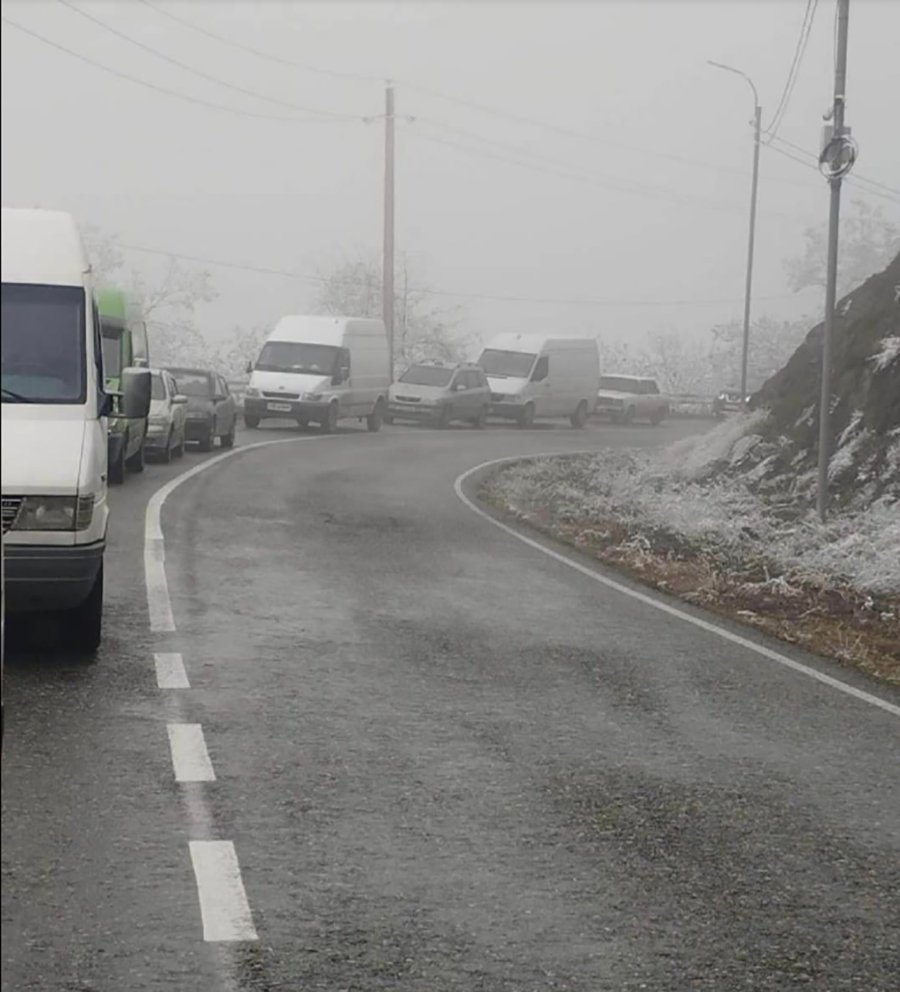
Armenian authorities are warning that Azerbaijan plans to cut off Artsakh’s only connection with Armenia through the Lachin corridor.
“Azerbaijan wants to cut that only and last link with the world, strangling Artsakh,” Artsakh President Arayik Harutyunyan said on December 7. Harutyunyan called for “additional international guarantees to ensure uninterrupted connection of Artsakh with Armenia and the external world” during his meeting with a delegation of French parliamentarians.
“We see the intention of the Azerbaijani side to close the Lachin corridor,” Armenian National Assembly speaker Alen Simonyan said on December 5. “The Lachin corridor is the only full corridor of humanitarian importance for the life-support of the Nagorno Karabakh Armenians.”

The warnings come after a week of tensions along the route between Artsakh and Armenia, raising fears that the future of the Lachin corridor is under threat.
On December 7, a group of journalists working for Azerbaijani state media were blocked from entering Stepanakert by Russian peacekeeping forces, according to a video circulated on social media. Russian peacekeepers have restricted access by foreign journalists since their deployment to Artsakh and the Lachin corridor after the end of the 2020 Artsakh War between Armenia and Azerbaijan.

On December 3, a group of state representatives from Azerbaijan shut down a section of the Stepanakert-Goris highway near Shushi, obstructing travel between Artsakh and Armenia for nearly four hours. Azerbaijani authorities said that government employees traveled toward Shushi from Stepanakert to address “environmental damage” arising from “illegal exploitation of minerals” in Artsakh.
The road was reopened after several hours of negotiations mediated by Russian peacekeepers. During the road closure, Artsakh authorities said that it was “impossible to transport medical supplies and medicines to Artsakh” or “people with serious health issues from Artsakh to Armenia.”
“It is obvious that by this step Azerbaijan is resorting to a provocation aimed at terminating the terrestrial connection between Armenia and Artsakh and subjecting the civilian population to psychological terror,” Artsakh officials said.
Following Saturday’s road closure, the Russian peacekeeping mission announced its plan to install new technical equipment along the Stepanakert-Goris road.
Head of the Russian peacekeeping force Andrei Volkov said that a customs station with special technical equipment would be set up on the first checkpoint in an interview broadcast on Azerbaijani public television. He said the agreement was reached as a result of negotiations between Russia and Azerbaijan.
Volkov’s interview sparked rumors in Artsakh and Armenia that an Azerbaijani roadblock would be placed on the Lachin corridor. During a meeting with the Artsakh State Security Service on December 5, Volkov said that the checkpoint or any other Russian checkpoint along the corridor, would not be controlled by Azerbaijanis. The Russian peacekeepers plan to install X-ray scanners at the checkpoint near Shushi to inspect vehicles and make sure prohibited items do not enter their zone of responsibility, according to Artsakh authorities.
Representatives from the Azerbaijan Ministry of Ecology and Natural Resources, the Ministry of Economy and AzerGold met with Russian peacekeepers twice this week to discuss the “importance of conducting monitoring, inventory of property and environmental research in fields where illegal exploitation of minerals is carried out,” the Azerbaijan Ministry of Ecology and Natural Resources said.
The Artsakh Environmental Committee responded that its “frequent monitoring has not identified any significant environmental risks associated with mineral use.”
“The Artsakh Republic takes care of the health of its population and the preservation of nature, despite the various difficulties as a result of the conflict and unrecognized status of the state,” the committee said on December 3.
On December 4, the day after the road closure, a physical altercation broke out between a group of Azerbaijanis in civilian clothes and residents in Artsakh. Officials say the Azerbaijanis “behaved rudely and provocatively” toward a group of Armenians during a pit stop in the Getavan community of the Martakert region of Artsakh while traveling along the Mataghis-Karvachar road. The passengers were “employees of the Azerbaijani armed forces and military police,” according to Artsakh authorities.
Russian peacekeepers have been deployed along the Lachin corridor since the end of the 2020 Artsakh War. Under the terms of the ceasefire, Armenia and Azerbaijan agreed to construct an alternate route within the next three years, to which Russian peacekeepers would be redeployed. This past summer, the Armenian residents of Aghavno, Nerkin Sus and the town of Berdzor along the Lachin corridor were evacuated after Azerbaijan demanded that Armenians start using the new route, largely constructed by Azerbaijani workers.
In the weeks before the road closure, Azerbaijani authorities accused Armenia of conducting prohibited activities along the Lachin corridor. On November 24, Azerbaijani Foreign Minister Jeyhun Bayramov said that Armenia buried mines in Artsakh transported along the Lachin corridor.
“The corridor is not being used for its intended purpose, and this must be stopped,” Bayramov told reporters, warning that Azerbaijan “will take all necessary steps.”
His Armenian counterpart Ararat Mirzoyan responded that the mines were not laid in Artsakh, but in parts of Armenia occupied by Azerbaijani forces during the border attacks of May 2021 and September 2022. He said the mines were laid “due to the constant high risk of new military aggressions by Azerbaijan.”
Azerbaijani President Ilham Aliyev has drawn parallels between the Lachin corridor and the so-called “Zangezur corridor.” The ceasefire agreement calls for the creation of a route connecting Azerbaijan and its exclave Nakhichevan through Armenia to guarantee “unimpeded movement of citizens, vehicles and goods in both directions.” Aliyev has demanded that Armenia provide a corridor free of passport or customs controls through its southernmost province Syunik. Armenian authorities have rejected this demand, stating that the ceasefire agreement does not call for the provision of a corridor, but of a transport route within Armenia’s jurisdiction, which it is ready to provide.



Be the first to comment